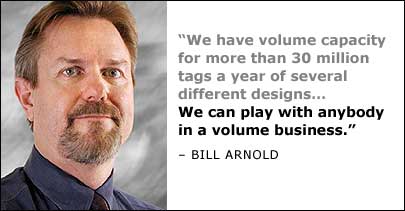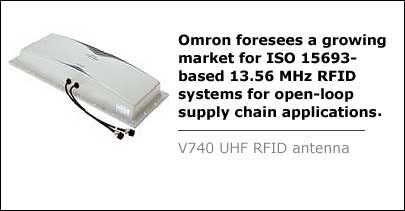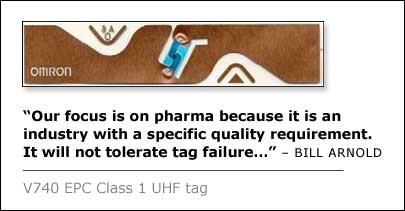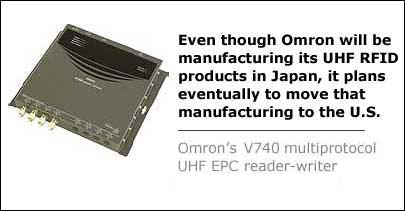The emergence of UHF RFID across company supply chains has already made many businesses reexamine the way they operate in order to maximize the potential benefits the technology might bring. However, that type of reassessment isn’t just for end users.
Omron, a manufacturer of sensing and automation products in Kyoto, Japan, has been producing RFID systems for more than 20 years. Still, the manufacturer has had to rethink its business in order to best meet the demands of the new market for UHF RFID. This week, Omron will announce it has created a new division, the RFID Business Development Group, to focus its efforts on UHF and HF standards-based equipment. The company says this unit is based not in Japan, but rather in the United States.
|
|
“Typically, a Japanese company will start a new business in Japan and try out new products there first. But although we have had experience in RFID for so long, supply chain application of tags is a whole new market, and we had to form in the U.S. first instead because the deployment action is primarily in the U.S.,” says Bill Arnold, chief strategist at Omron’s new RFID unit. Omron’s new unit has sales offices in Schaumburg, Ill., but it also rents space from Omron Electronics, the company’s industrial automation division in St. Charles, Ill., for its lab and test operation. So far, the unit employs fewer than 40 people in its sales offices in the United States, Shanghai, China, and Europe, but the company says those numbers will grow rapidly. Omron says it will have spent $20 million on its RFID initiatives worldwide by the end of next year, and underlining the importance of the new unit to the company, the company’s president and chief executive officer, Hisao Sakuta, has appointed himself its project leader.
Omron’s previous RFID work had focused largely on the development of customer-specific 125 kHz and 13.56 MHz RFID systems for closed-loop factory automation. Industrial automation, including both RFID and non-RFID systems, accounts for around 40 percent of Omron’s nearly $6 billion in total annual revenue. Electronic components such as embedded sensors and switches primarily for the communications and automotive market represent 28 percent of revenue, while equipment for transportation systems and the health-care market together account for between 12 to 14 percent. These products employ proprietary protocols developed by Omron to work in conjunction with its programmable controllers and other automation products. The tags for these applications, usually environmentally hardened by encapsulation, are designed for withstanding reuse and rewrites for 10 or more years.
The company’s RFID experience, however, hasn’t been only in proprietary systems. For the past seven years, the company has been producing ISO 15693 standard 13.56 MHz high-frequency (HF) interrogators (readers), antennas, inlays and tags made with chips from its key semiconductor partner, Philips. Because of maturity in the 13.56 MHz RFID market, Omron says, equipment based on the ISO 15693 vicinity card standard is now being used for some closed-loop applications. Omron’s ISO 15693-based HF equipment has been deployed by a number of industries in a variety of such applications, ranging from tagging books in libraries to plates in sushi restaurants and bicycles at parking facilities in Japan.
Omron, however, foresees a growing market for ISO 15693-based 13.56 MHz RFID systems for open-loop supply chain applications. The company notes that many new supply chain-focused applications being developed can use this technology, especially in the pharmaceutical sector, and that EPCglobal plans to develop an EPC standard for 13.56 MHz. Therefore, the new RFID Business Development Group has taken over responsibility for developing the company’s existing V720 line of ISO 15693-based HF products, as well as its newer V740 series of Class 1 Generation 1 EPC UHF inlays, readers and antennas, and for selling them to end users and systems integrators.
“The supply chain is more of a horizontal market with deployments in warehouse and distribution centers across large and medium-sized companies. These are not the folks we have been selling factory automation systems to, or [whom] we can call on. [As far as customer relationships go], Omron was starting from a blank page,” says Arnold.
Although Omron debuted its new RFID business unit this week, it has been offering EPC readers and inlays in the United States for more than a year. Omron introduced its UHF interrogators in March 2004, and its 96-bit Class 1 Gen 1 tags started shipping in production quantities in February. The firm claims a number of issues prevented the company from getting its UHF products to market more quickly. These involved such aspects as its supplier partnerships and the way it develops its own products.
Initially, Omron had not intended to offer UHF inlays until the EPCglobal Class 1 Generation 2 specification was ratified. However, delays to the EPC Gen 2 specification and the emergence of the UHF EPC tag market forced the company to launch its EPC Class 1 Gen 1 inlays. Because the company’s strategic RFID silicon partner, Philips, had already decided it would not develop EPC products prior to Gen 2, Omron was forced to look elsewhere for its UHF RFID chips. Thus, it opted to use 96-bit Class 1 chips from ST Microelectronics.
When it began making sample Gen 2 inlays this fall, Omron tapped Impinj, the first company to offer Gen 2 samples, to supply it with RFID chips. “Every chip has a unique footprint,” says Arnold. “We had never handled an Impinj chip, but we have configured our machinery to work with chips from a number of companies. We have [Gen 2 chip] samples from Impinj, ST Micro and Philips working on the same machines. It gives us options.”
To get into the UHF reader market, the company again opted to work with partners. For its V740 interrogators, Omron licensed ThingMagic‘s reader design but says its engineers completely redeveloped the product, causing Omron to delay the launch of its UHF reader until March 2004. “Our multiprotocol reader uses the ThingMagic operating system, but we redesigned the reader—replacing a number of components and redesigning the board layout to meet Omron’s quality and performance requirements,” Arnold explains. According to Omron, while ThingMagic had a workable design, it was not up to Omron’s mean time between failure (MTBF) standards and many other component-level requirements for specification tolerance.
Even though the RFID Business Development Group is based in the United States, its RFID equipment will be designed and manufactured in Japan, alongside Omron’s other RFID products. However, as the company looks to establish itself in the U.S. UHF RFID market, it says it will bring its engineers and product development teams to this country for visits up to four months, working with its U.S. customers to best understand their RFID system requirements. The engineers will then return to Japan to develop the required products.
In March of this year, for example, Omron brought over its engineers from Japan to develop UHF RFID inlays from scratch for an item-tagging project being undertaken by an undisclosed U.S. pharmaceutical maker. “We started with only a requirement that it be 1-inch square or less in size, and be able to be read from 2 to 3 feet as a single tag,” says Arnold, “plus that 72 tags could all be read at one time on a conveyor when packed into a case. From this requirement, we developed an initial prototype, gathered samples of the target application bottles, refined the design and moved to production within three months of the initial customer conversation.” By the following September, he says, Omron was producing rolls of inlays in the required quantities.
Omron believes it will win its share of the UHF market, not by its speed to market, but by the quality and pricing of its offerings. “We will grow business by showing the market reliable, high-quality and cost-effective products,” Arnold states.
The pharma trial, combined with the company’s existing offerings in HF RFID, has lead Omron to focus its new RFID efforts in the pharmaceutical market. “Pharma will use a mixture of UHF and HF technology, as well as demand high-quality products for specific applications. Our focus is on pharma because it is an industry with a specific quality requirement. It will not tolerate tag failure, and that gives us an advantage,” he adds.
Omron is so confident in its ability to deliver high-quality, reliable inlays that it is currently underwriting a guarantee offered by the R and V Group—one of three U.S. label converters currently certified by Omron to sell labels with its inlays—to replace any nonfunctioning Gen 1 tag in kind, at no charge to the end user.
“We based our guarantee on the label converter’s ability to handle and test our inlays. R and V has invested in the best equipment to do that,” says Arnold. At present, Omron says it is shipping its inlays to converters with just a 2 to 3 percent failure rate. That will go down to fractions of a percent within a few years, Arnold predicts, as Omron refines its UHF design and manufacturing processes so that its UHF inlays offer the same reliability level as HF inlays do today.
While targeting the pharma market at present, Omron believes it can grow and establish itself through the quality of its products within the mass market—not in specialized systems and applications. “We have volume capacity for more than 30 million tags a year of several different designs,” Arnold reports. “We also have a process to make inlays competitive with [those of] anyone in the world. We can play with anybody in a volume business.”
Omron’s conviction in its ability to produce high-quality, reliable inlays is founded in large part on “Jomful,” its own patented process for ultrasonically bonding an RFID chip to an antenna. The company developed this technology to improve the reliability of its HF offerings, and that experience has been carried over into its UHF inlay manufacturing. According to Omron and R and V, the technique enables a very robust union, able to withstand 1,000 hours at a high temperature (185 degrees Fahrenheit), a high relative humidity (85 percent) and significant bending.
According to R and V, its studies have shown that after 300 bends of a tight, fixed radius, there were no failures with Omron inlays. On the other hand, competitive RFID inlays reportedly failed after 50 bends. In addition, Omron claims that the bonding process is very quick—0.3 to 0.5 seconds—enabling mass-production volumes and reducing the cost of production.
Even though Omron will be manufacturing its UHF RFID products at its factory in Shiga, Japan, additional manufacturing capacity could be added in United States as demand grows, according to Arnold. The company says it’s impossible to estimate the potential timing for the production to move to the United States, but as the market grows and its volumes expand, having production located nearer the point of distribution may become a competitive advantage. Moreover, with different frequency requirements, it may become more efficient to produce the various frequency designs in separate production facilities.
Omron’s revenue from UHF equipment sold in the United States will total several million dollars this year, Arnold says, and its new RFID Business Development Group remains tiny compared with the resources and revenues of other Omron units. With the focus and the weight of its parent’s manufacturing base and experience behind it, however, Arnold is confident the new RFID unit will break even next year and be profitable by 2007.





